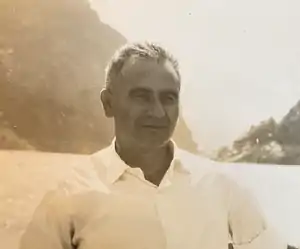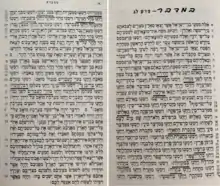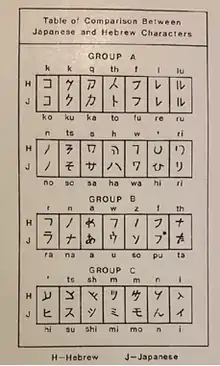Joseph Eidelberg
Joseph Eidelberg (Hebrew: יוסף אידלברג) (February 8, 1916 – August 21, 1985) was an Israeli military commander and a plant manager of large Israeli corporations. During his career he developed a hobby of exploring religions’ roots and languages. He became a linguistics researcher, a scholar speaking seven languages, an Historian explorer, and an author of three books. His research work focused on the two most puzzling mysteries in Jewish history: The Exodus, a 40-year desert travel of the Israelites from Egypt to Canaan, and the Ten Lost Tribes of Israel, which were never found. A summary in his memory was written by his friend Colonel (ret.) Meir Pa'il Ph.D.(Hebrew: מאיר פעיל).[1] A professional opinion on Eidelberg's work was detailed by Dr. Harold Goldmeier, a former Research and Teaching Fellow at Harvard University.[2] His research claimed to show evidence that the Exodus journey took place in North Africa including Nigeria, the land of Igbo Jews, and to have found evidence supporting the Japanese-Jewish common ancestry theory. Publications of work by Eidelberg, from 1972 to 2015, amount to "15 works, in 35 publications, in 3 languages and 153 library holdings".[3]

Early life
Eidelberg was born to Haim and Clara in Odessa. At the age of 7, his family moved to Mandatory Palestine (now Israel), where they lived in Jerusalem and in Haifa. At age 22, he went to England to pursue engineering. Shortly after, before World War II, he returned to Palestine and volunteered for the British Army as a special security officer of the Notrim. He later joined the Haganah and served as the communication officer of the Haifa district.[4] In 1943, Eidelberg headed "Am Lohem" (Hebrew: "עם לוחם"), (Fighting Nation), organization.[5] He fought in the Israeli Independence war in 1948 and continued serving as a Major in the Israeli Defense Forces for five more years.[1]
Engineering Management Career
Before Eidelberg joined the IDF, he moved with his family to Natanya and worked at the Zusmann machine shop company, on weapon development of rocket launchers for the Haganah. In 1948, he published a technical book and tables, for metal workers and technicians, under the Hebrew family name Hardin (Hebrew: הרדין), but later decided to maintain his original family name Eidelberg. During his military service in the Israeli Defense Forces (IDF) (1948-1953) he moved with his family to Holon, and served as the Engineering Corps (Hebrew: חיל הנדסה) Base Commander in Sarafand (Tzrifin). He completed paratrooper training and graduated from the Battalion Commanders' College of the IDF with Meir Pa'il. During his military service, he initiated a process of rapid clay housing construction and pre-military vocational training for young adults. [1] After his discharge from the IDF in 1953, he went to the US to finish his Mechanical Engineering studies at Tri State College (Trine University) in Angola, Indiana. Eidelberg completed his engineering studies in 1955.
From 1955 to 1956, Eidelberg worked as a Project Manager for Mekorot, in the construction of the Haifa Tel Aviv water line, and the construction of the Ein Harod water reservoir. In 1956, he took part in the Sinai War, after which he became the Plant Manager of the Timna Valley Copper Mines. In 1958, Eidelberg became the General Manager of the Dead Sea Works until 1961, reporting to the Director General Mordechai Maklef (Hebrew: מרדכי מקלף), who was a retired Chief of staff of the IDF. From 1961 to 1964, he served as the General Manager of the Israel Shipyards. Between 1964 and 1968 he became the Branch Manager of Tahal, Iran, where he started exploring the mystery of the Ten Lost Tribes. He later became the manager of the Tahal branch in the Ivory Coast (1968-1972), where he explored the mystery of Exodus. From the mid-1960s until his death in 1985, Eidelberg continued exploring and writing books about The Exodus and the Ten Lost Tribes of Israel.[1]
Historian of Ancient Hebrew Mysteries
Exodus Through North African Desert
In 1969, while working in the Ivory Coast, Eidelberg claimed to have found that a tribe in Mali, named Bambara, that, according to him, spoke ancient Hebrew and ate Manna daily. His research, which followed, was detailed in his Hebrew book, “Bambara, A new Approach for solving the puzzle of Exodus and the mystery of the Ten Lost Tribes of Israel” (Hebrew: במברה גישה חדשה לפענוח חידת יציאת מצרים ותעלומת עשרת השבטים). The first edition of Bambara was published by Eidelberg in 1972 with publishing house Hamatmid.[6] The linguistics foundation of his theories was written in 1977 in a short print, which was never published, "BAMBARA (A PROTO-HEBREW LANGUAGE?)".[7] Forty-two years later, in 2014, a second edition was published by his son with Gefen Publishing House. The book title of the second edition included In Footsteps towards the Pillar of Fire (Hebrew: בעקבות עמוד האש).[8] The title change highlights one of Eidelberg's theories, that Mount Sinai is Emi Koussi, an active volcano in North Africa, which created a Pillar of Fire (Hebrew: עמוד האש). The Pillar of Fire, according to the Biblical story, led the Israelites, with its fire during the night and its smoke during daylight, to the place where Moses gave them the Ten Commandments from God. A similar theory was presented in 2012 by Avigdor Shahan (Hebrew: אביגדור שחן) in his Hebrew book “This is Sinai, The mountain and the desert that the Israelites wandered through Africa” (Hebrew: זה סיני! ההר והמדבר שבו נדדו בני ישראל ביבשת אפריקה ).[9] The book credits Eidelberg for his related discoveries with the following translated statements:


- With Deep Thanks (Translated from Hebrew, Ze Sini, Top of the list on page 15)
“To the engineer researcher, Joseph Eidelberg, whose Books Bambara and The Japanese and The Ten Lost tribes of Israel, lighten my way for forty years until my writing of this book”
- Book's Theme dedication to Eidelberg (on Top of introduction page 17)
“There is an old saying which states: whoever follows a road which many went there before, sees what many others already saw. The one who goes in a road that very few went before, sees what very few saw before. And I followed the footsteps of Joseph Eidelberg, the one and only one that paved the road in which The Israelites, who left Egypt, walked through more than three thousand and five hundred years ago. My Book is another layer of this fascinating road”
- About Eidelberg in the Introduction closure (p. 21-23)
“My way of researching Exodus did not follow the roads of other researchers with the exception of one of them, whose way broke through a new road: My buddy and friend, the father of Exodus through African continent, a (ret.) Major, historian and a researcher of religions and ancient languages. The engineer, Joseph Eidelberg, who knew how to look farther beyond the historical horizon which was written by scholars….”
The Japanese and the Ten Lost Tribes of Israel
In 1980, after spending a year in a Shinto Shrine, Eidelberg published his second history book “The Japanese and the Ten Lost Tribes of Israel”, by the publisher Zur-Ot. The book expanded his theory of the route, which the exiled Lost Tribes of Israel took from Samaria, though Asia and which ended up, according to his theory, in Japan. The theory also includes additional similarities in traditions, mythological stories, writings, and rituals, as well as hundreds of Japanese words and symbols whose genesis were narrated from ancient Hebrew. The book was translated into Japanese by Kazuo Nakagawa and sold at an estimated 40,000 copies.[10] Its 2nd edition was published 24 years later, in 2014, by his son with Gefen Publishing House.[11] A similar theory was presented in 2003 by Avigdor Shachan in chapter 14 of his Hebrew book, “Towards the Sambation: a Journey following the footsteps of the 10 Tribes” (Hebrew: אל עבר הסמבטיון מסע בעקבות עשרת השבטים) .[12] Shachan's book was translated into English in 2007 with the title In the Footsteps of the Lost Ten Tribes.[13] Both of these books by Shachan have considerable reference to Eidelberg's related discoveries.

The Biblical Hebrew Origin of the Japanese People
Following the publication of his second book, Eidelberg deepened his research about the relationship between the Japanese and the ancient Hebrews, in his third book, “The Biblical Hebrew Origin of the Japanese People”. In this last book, he tabulated hundreds of words in Japanese with similar sounds and meanings to Hebrew. His research ended shortly before his death in 1985. After his death, the manuscript of the book was organized by his sister and published in 2005 by his son with Gefen Publishing House.[14] The book was translated into Japanese by Arimasa Kubo in 2012.[15] Eidelberg's theories were cited in other publications which followed. His theory about the Ten Lost Tribes of Israel was presented in a series of seven episodes by a Japanese TV broadcasting station.
Reaction
Historians
- In Support: "Israelites Came to Ancient Japan" [16]
- In Doubt: "The author's thesis does need more investigation in order to substantiate a majority off his claim" [17]
- In Dispute: "The Japanese are not Hebrews!" [18]
- In Depth: "Dr. Eiji Kawamorita, a hebraic scholar took a view that was a combination of Kubo and Eidelberg" [19]
- on Line: "The Roots of Japan Were Ancient Israel!?" - 7 Part TV Series [20]

Articles and Editorials
Readers Views
- Lost Tribes Cafe Book Review: The Biblical Hebrew Origin of the Japanese People [27]
- Amazon Opiniones de clientes (4.1/5) [28]
"I have no doubt that the Japanese stem from the Ten Lost Tribes of Israel"
"Presented facts, particularly linguistic facts that can't be refuted."
"I found it fascinating but too expensive"
"A worth-while and grasping reading"
" Whether you agree or not, Eidelberg's book appears destined to stir debate for years to come."
"Excellent, insightful, fascinating book with an incredible foundation of extensive research. Brilliant"
"An extraordinary book."
Personal life
Joseph's father, Haim Eidelberg, an industrial construction entrepreneur in Haifa Bay, was a Russian soldier, who was wounded in World War I. He immigrated to Palestine with his wife Clara, son Joseph, and daughter Dina.[6,p. 9] Dina Harris was for many years the secretary of Yad Hanadiv. His brother, Jonah Eidelberg, was born in Mandatory Palestine (now Israel) and became a naval academy cadet and a demolition officer in the IDF. During the 1947–1949 Palestine war (Hebrew: מלחמת העצמאות), he fought in Al-Nabi Yusha'.[29] He later went to the US to study engineering, followed by an engineering management career. Eidelberg was married to Zipora Zitrin in 1943 and was separated in 1964. His son, Boaz Eidelberg, Ph.D.,is a mechanical engineer, university professor, and a private pilot. His granddaughter Yael completed Law and Business schools and works for hi-tech company Intel. His grandson Tal Eidelberg is a Computer Science entrepreneur, founder, and CEO of a Healthcare scheduling company. [30]
References
- Pa'il, Meir (2005). The Biblical Hebrew Origin of the Japanese People(p.xvii). Gefen Publishing House. ISBN 9789652293398.
In Loving Memory of Joseph Eidelberg
- Goldmeier, Harold. "Jewish Geography and the Japanese". Arutz Seva 7.
Eidelberg is the kind of man with whom I would have liked to share a lengthy dinner
- "Eidelberg, J. History, 15 works in 35 publications in 3 languages and 153 library holdings". WorldCat Identities. 1972–2015.
15 works in 35 publications in 3 languages and 153 library holdings
CS1 maint: date format (link) - "היוזמה והקמת ארגון עם לוחם". עמותת דור הפלמ֞ח֞.
אנשי הפלמ"ח הצטרפו ל'עם לוחם' בתיווכו של יוסף איידלברג
- "עם לוחם". Wikipedia.
הגוף החדש נקרא בשם "עם לוחם", בראשו עמד יוסף אידלברג
- אידלברג, יוסף (1972). במברה גישה חדשה לפענוח חידת יציאת מצרים ותעלומת עשרת השבטים. הוצאת המתמיד. p. 182.
- Eidelberg, Joseph (1977). "BAMBARA (A PROTO-HEBREW LANGUAGE?)". Joseph Eidelberg Legacy Site.
The purpose of this work is to bring to the attention of linguists the Syllabological approach to the diachronic study of languages
- אידלברג, יוסף (2014). במברה - בעקבות עמוד האש : גישה חדשה לפענוח חידת יציאת מצרים ותעלומת עשרת השבטים. גפן בית הוצאה לאור. p. 182. ISBN 9789652296580.
- שחן, אביגדור (2011). זה סיני!:ההר והמדבר שבו נדדו בני ישראל ביבשת אפריקה [This is Sini! The mountain and the desert in which the Israelites wandered in the African continent] (in Hebrew). בית יהושע:א.שחן.
- Eidelberg, Joseph; Nakagawa, Kazuo (1984). Yamato minzoku wa Yudayajin datta: Shutsu Ejiputo kara Nihon e no mich [Japanease and the Ten Lost Tribes of Israel.] (in Japanese). Shohan. ISBN 9784884811273. OCLC 39031678.
- Eidelberg, Joseph (2014). The Japanese and the Ten Lost Tribes of Israel. Gefen Publishing House. p. 168. ISBN 9789652296597.
- שחן, אביגדור (2011). אל עבר הסמבטיון מסע בעקבות עשרת השבטים [Towards the Sambation a Journy following the footsteps of the 10 Tribes] (in Hebrew). הקיבוץ המאוחד.
- Shachan, Avigdor (2007). In the Footsteps of the Ten Lost Tribes. Devora Publishing Company. p. 480.
- Eidelberg, Joseph (2005). The Biblical Hebrew Origin of the Japanese People. Gefen Publishing House. p. 144.
- Eidelberg, Joseph; Kubo, Arimasa (2005). Nihon shoki to nihongo no yudaya kigen (Japonés) Tankobon [The Biblical Hebrew Origin of the Japanese People] (in Japanese). ISBN 4198621101.
- Kubo, Arimasa. "Israelites Came to Ancient Japan". Remnant.
Joseph Eidelberg, a Jew who once came to Japan and remained for years at a Japanese Shinto shrine, wrote a book...
- The, Granovitch (January 3, 2010). "The Biblical Hebrew Origin of the Japanese People". DARK IMPULSES.
The author's thesis does need more investigation in order to substantiate a majority off his claim
- "The Japanese are not Hebrews!". Brit-Am.
Eidelberg suggests (p.68) that "Ise" is a form of "Jebus" meaning Jerusalem...
- yamatosaxon (March 24, 2013). "THE LOST TRIBES, NESTORIANS AND CHRIST IN JAPAN". The Daily Beagle.
Eidelberg’s book goes on to list thousands of words that he claims are rooted in Hebrew. Some of these seem quite stretched but others do have a similarity
- "The Roots of Japan Were Ancient Israel!?" (in Japanese). Japan: iSkySoft. August 21, 2011.
- Berg, Irwin (Autumn 2007). "BOOK COMMENT THE BIBLICAL HEBREW ORIGIN OF THE JAPANESE PEOPLE By Joseph Eidelberg (Gefen 2005)" (PDF). KULANU. 14 (page 9): 14.
- RONNEN, MEIR (November 14, 2005). "Words, words, words".
- טוכפלד, מיכאל (June 26, 2015). "קופסה על הראש וציצית: נזירים ביפן מעשרת השבטים?" [Box on the head and tassel: Priests in Japan from the Ten tribes?] (in Hebrew).
- כ"ץ כוהן-צדק, אוולין (November 4, 2014). "המסלול של יציאת-מצריים- כיום" [The route of Exodus- Today] (in Hebrew).
- אשד, אלי (February 2013). "קהילת קודש טימבוקטו" [The holy community of Timbuktu] (in Hebrew).
- Hiroshi Hayashi (July 11, 2019). The lost ten tribes of Israel + Japan (in English and Japanese). Hamamatsu-city, Japan: YouTube. Event occurs at 0-3:29 / 55:16.
- Lost Tribes Cafe Book Review: The Biblical Hebrew Origin of the Japanese People. YouTube. December 23, 2019.
It is fascinating and I highly recommend it
- "Amazon Opiniones de clientes". Amazon.
- "'הכשרת דפנה 1947 גרעין צופים ה". מוזיאון הפלמ"ח.
אידלברג יונה (היה בגדוד "אלון" בגולני, עבר ליפתח בצריפין, כשחזר ביוני מקורס ממי'ם)
- "TAL EIDELBERG". Bizapedia.
Tal Eidelberg is listed as a Chief Executive Officer with Intrigma Inc.
